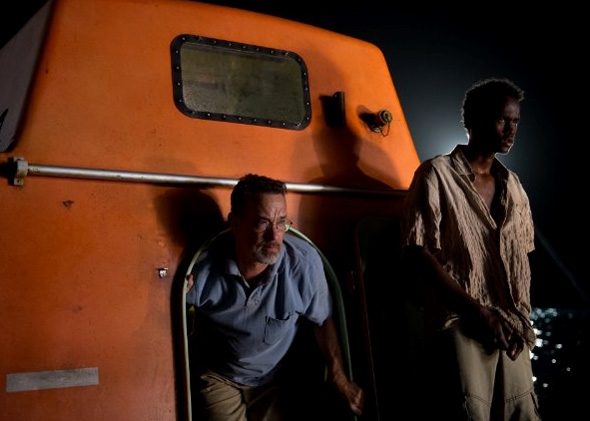Captain Phillips
Oscar, ho!

Photo by Jasin Boland/Columbia Pictures Industries Inc.
After you've seen Captain Phillips, come back and listen to Slate's Spoiler Special with Dana Stevens and David Weigel.
You can also download the podcast here.
The defining scene of Paul Greengrass’ Captain Phillips occurs in the last few minutes, after the cargo-ship captain of the title, played by Tom Hanks, has survived his ordeal of being taken hostage on a lifeboat by four Somali pirates off the coast of Africa. It isn’t spoiling anything to note that the captain makes it off the lifeboat alive—after all, the real-life Richard Phillips went on to write a book about the harrowing 2009 hijacking of his ship, upon which this movie (written by Billy Ray of Shattered Glass and The Hunger Games) is based. But the way Greengrass treats the moment is something I won’t spoil, except to say that this last scene exemplifies the compassion and truthfulness that sets this movie apart from your run-of-the-mill maritime action thriller (and that it very well may be the reason Tom Hanks wins an Oscar).
That powerful last scene had its work cut out for it in my case, because by the time it rolled around, I was starting to lose patience with Captain Phillips, the second half of which takes place almost entirely in a claustrophobic enclosed lifeboat. Greengrass has an impressive gift for creating tension with his trademark documentary-style shaky camera (here wielded by frequent Greengrass collaborator Barry Ackroyd), but he’s not always so great at diffusing that tension, or modulating its rhythms over the course of a film (which is part of why I sat through his 9/11 re-creation, United 93, with an uneasy combination of anguish and boredom). That second hour in the lifeboat, suspenseful as it is, makes for a long stretch of uninterrupted intensity, especially when filmed in Greengrass’ jolting quick-cut style. It’s effective on a visceral level, but so unvaryingly clamorous and chaotic that I, for one, found myself at times as eager to get out of the movie as Captain Phillips was to get off the boat.
The first hour is much more effectively paced, even if there’s something off about the opening scene, in which Phillips and his wife (Catherine Keener) have a curiously programmatic chat about the economically unstable world their children are growing up into. The thematic import of that conversation becomes clear in the next scene, as a group of desperate young Somali fishermen haggle with a warlord for a place on the crew of the next pirate expedition he’s sending out. In addition to being an action-adventure about captors and hostages, Captain Phillips is a tragedy about the ruinous consequences of global capitalism. The would-be pirates may have it unimaginably worse than the middle-class Phillipses, but everyone we see onscreen is just a working man doing what he feels he has to do to get by. (And given that Keener’s character disappears after that first scene, never to be replaced by another female face, I do mean “he.”)
Once the pirates have boarded the Alabama, though—in a staggering David-and-Goliath raid in which four scrawny Somalis in a broken-down skiff manage to breach the defenses of a massive American cargo ship on full alert—you’ll be too busy trying to catch a breath to pick up much political subtext. The head of the pirate crew is the hotheaded, acutely status-conscious Muse (unforgettably embodied by Barkhad Abdi, who was recruited from the Somali community of Minneapolis for his first film role). Captain Phillips, on the other hand, is a seasoned leader under pressure, a fact Greengrass establishes with an admirably light touch—no sentimental heroics here, just brisk pragmatism. He manages to warn most of his crew in time for them to hide in the engine room, where he communicates with them by walkie-talkie from the bridge as he negotiates with the hijackers. In an agonizingly intense scene, the frightened, squabbling pirates force Phillips to take them on a tour of the ship, slowly zeroing in on the place we know the entire crew is hiding.
Eventually Phillips persuades the pirates to leave on a lifeboat with the $30,000 from the ship’s safe. But the Somalis take him hostage, resulting in an international incident that will entail the parachuting in of Navy SEALs. Although the pace flags as described above while we’re waiting for the SEALS to arrive, the eventual rescue operation is staged with great skill and tension (and even, rare for Greengrass, the occasional stationary establishing shot). The scenes in which the hijackers meet their various fates—I won’t spoil them if you don’t remember the story, but none are pleasant—have something of the feel of the raid on the Bin Laden compound in Zero Dark Thirty, a taste of bitter, ambivalent victory. And then comes that transcendent last scene, in which the man whose side we’ve barely left during this incredible ordeal is suddenly revealed as the best kind of hero, not super at all but ordinary and vulnerable and human.
